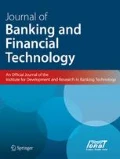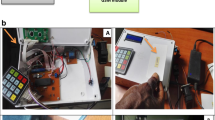Abstract
This paper describes an expert RFID biometric enabled dual system architecture which acts as a smart and digitized banking vault door locking system. The proposed system is novel, multipurpose and provides three levels of security. It is based on locker automation using RFID technology and software Android App technology that allows access only to the authorized owner of the bank vault to open it. Despite the legacy key system, the overall control of electronic smart door lock system utilizes the RFID tags via NFC, biometric traits via web portal and mobiles via Bluetooth as the procedure for authentication. Our proposed RFID technology-based access control authentication mechanism utilizes low cost irrevertible functions to control the vulnerable security attacks. Furthermore, the proposed lock system has a tag’s identification search complexity of only \({\mathcal {O}}(1)\).







Similar content being viewed by others
References
Baidya J, Saha T, Moyashir R, Palit R (2017) Design and implementation of fingerprint based lock system for shared access. In: 2017 IEEE 7th annual computing and communication workshop and conference, pp 1–6
Farooq U, Hasan MU, Amar M, Hanif A, Asad MU (2014) RFID based security and access control system. IACSIT Int J Eng Technol 6(4):309–314
Wu DL, Ng WW, Yeung DS, Ding HL (2009) A brief survey on current RFID applications. IEEE Conf Mach Learn Cybern 4:2330–2335
Verma GK, Tripathi P (2010) A digital security system with door lock system using RFID technology. Int J Comput Appl 5(11):6–8
Juels A (2006) RFID security and privacy: a research survey. IEEE J Sel Areas Commun 24(2):381–394
Omidiora EO, Fakolujo OA, Arulogun OT, Aborisade DO (2011) A prototype of a fingerprint based ignition systems in vehicles. Eur J Sci Res 62(2):164
Kawale A (2013) Fingerprint based locking system. Int J Sci Eng Res 4(5)
Yugashini I, Vidhyasri S, Gayathri Devi K (2013) Design and implementation of automated door accessing system with face recognition. Int J Sci Mod Eng 1(12)
Sayemul I, Saiduzzaman MD (2013) Design of a bank vault security system with password, thermal physical interrupt alarm. Int J Sci Eng Res 4(8)
Ray R, Uddin MA, Islam SF (2016) GSM based bank vault security system. Int J Comput Sci Inf Secur 14(2):35
Ramani R, Selvaraju S, Valarmathy S, Niranjan P (2012) Bank locker security system based on RFID and GSM technology. Int J Comput Appl 57(18)
Grewal K, Mishra R, Chaurasiya N, Singh P (2015) RFID based security and access control system using Arduino with GSM module. IJEEE 2(2)
Crystalynne C, Badwal JS, Hipolito JR et al (2016) Development of microcontroller-based biometric locker system with short message service. Lect Notes Softw Eng 4(2):103
Meng XL, Song ZW, Li XY (2010) RFID-based security authentication system based on a novel face-recognition structure. In: IEEE proceedings of WASE international conference on information engineering, vol 1, pp 97–100
Wu DL, Ng WW, Chan PP, Ding HL, Jing BZ, Yeung DS (2010) Access control by RFID and face recognition based on neural network. In: IEEE international conference on machine learning and cybernetics, vol 2, pp 675–680
Peris-Lopez P, Hernandez-Castro JC, Estevez-Tapiador JM, Ribagorda A (2006) \(LMAP\): a real lightweight authentication protocol for low cost RFID tags. In: Proceedings of 2nd workshop on RFID security, pp 1–12
Peris-Lopez P, Hernandez-Castro JC, Estevez-Tapiador JM, Ribagorda A (2006) \(M^2AP\): a minimalist mutual authentication protocol for low cost RFID tags. In: Proceedings of UIC’06, vol 4159. Springer, Berlin, pp 912–923
Peris-Lopez P, Hernandez-Castro JC, Estevez-Tapiador JM, Ribagorda A (2006) \(EMAP\): an efficient mutual authentication protocol for low cost RFID tags. In: Proceedings of IS’06, vol 4277. Springer, Berlin, pp 352–361
Li T, Wang G (2007) Security analysis of two ultra-lightweight RFID authentication protocols. In: New approaches for security, privacy and trust in complex environments. Springer, Berlin, pp 109–120
Li T, Deng R (2007) Vulnerability analysis of EMAP-an efficient RFID mutual authentication protocol. In: IEEE international conference on availability, reliability and security ARES 2007, pp 238–245
Chien HY (2007) \(SAS1\): a new ultralightweight RFID authentication protocol providing strong authentication and strong integrity. IEEE Trans Dependable Secur Comput 4(4):337–340
Phan RCW (2009) Cryptanalysis of a new ultralightweight RFID authentication protocol SASI. IEEE Trans Dependable Secur Comput 6(4):316–320
Sun HM, Ting WC, Wang KH (2009) On the security of Chien’s ultralightweight RFID authentication protocol. IEEE Trans Dependable Secur Comput 2:315–317
Peris-Lopez P, Hernandez-Castro JC, Estevez-Tapiador JM, Ribagorda A (2008) Advances in ultralightweight cryptography for low cost RFID tags: Gossamer protocol. In: Proceedings of WISA’08, vol 5379. Springer, Berlin, pp 56–68
Bilal Z, Masood A, Kausar F (2009) Security analysis of ultra-lightweight cryptographic protocol for low-cost RFID tags: Gossamer protocol. In: International conference on network-based information systems NBIS’09, pp 260–267
Lee YC, Hsieh YC, You PS, Chen TC (2009) A new ultralightweight RFID protocol with mutual authentication. In: Proceedings of WASE’09, vol 2, pp 58–61
Kulseng L, Yu Z, Wei Y, Guan Y (2010) Lightweight mutual authentication and ownership transfer for RFID systems. In: IEEE Proceedings INFOCOM2010, pp 1–5
Yang Y, Gu J, Lv C, Jiang Q, Ma W (2012) Security analysis of Kulseng et al.’s mutual authentication protocol for RFID systems. IET Inf Secur 6(4):239–248
Tian Y, Chen G, Li J (2012) A new ultralightweight RFID authentication protocol with permutation. IEEE Commun Lett 16(5):702–705
Avoine G, Carpent X (2013) Yet another ultralightweight authentication protocol that is broken. In: Radio frequency identification. Security and privacy issues, pp 20–30
Jeon IS, Yoon EJ (2013) A new ultra-lightweight RFID authentication protocol using merge and separation operations. Int J Math Anal 7(52):2583–2593
Wang S, Liu S, Chen D (2014) Security analysis and improvement on two RFID authentication protocols. Wirel Pers Commun 82(1):1–13
Zhuang X, Zhu Y, Chang CC (2014) A new ultralightweight RFID protocol for low-cost tags: \(R^{2}AP\). Wirel Pers Commun 79(3):1787–1802
Juels A, Weis SA (2009) Defining strong privacy for RFID. ACM Trans Inf Syst Secur 13(1):7
Kaul SD, Awasthi AK (2017) Security flaws in two recently proposed RFID authentication protocols. Int J Comput Appl 50:1–8
Luo H, Wen G, Su J, Huang Z (2016) SLAP: succinct and lightweight authentication protocol for low-cost RFID system. Wirel Netw. https://doi.org/10.1007/s11276-016-1323-y
Stinson DR, Paterson M (2018) Cryptography: theory and practice. CRC Press, Boca Raton
Forouzan BA (2007) Cryptography & network security. McGraw-Hill, New York
Chi L, Zhu X (2017) Hashing techniques: a survey and taxonomy. ACM Comput Surv (CSUR) 50(1):1–36
Mujahid U, Muhammad N, Shami MA (2015) RCIA: a new ultralightweight RFID authentication protocol using recursive hash. Int J Distrib Sens Netw 11(1):642180
Mujahid U, Muhammad N, Sarwar S (2017) A new ultralightweight RFID authentication protocol for passive low cost tags: KMAP. Wirel Pers Commun 94(3):725–744
Aghili S, Mala H, Kaliyar P, Conti M (2019) SecLAP: secure and lightweight RFID authentication protocol for medical IoT. Future Gener Comput Syst 101:621–634
Naveed AM, Chua KC, Sikdar B (2017) Physically secure mutual authentication for IoT. In: 2017 IEEE conference on dependable and secure computing. IEEE, New York, pp 310–317
Varadharajan V (1989) Verification of network security protocols. Comput Secur 8(8):693–708
Armando A, Alessandro DB et al (2005) The AVISPA tool for the automated validation of internet security protocols and applications. In: International conference on computer aided verification. Springer, Berlin, pp 281–285
Molnar D, Wagner D (2004) Privacy and security in library RFID: issues, practices, and architectures. In: Proceedings of the 11th ACM conference on computer and communications security. ACM, New York, pp 210–219
Bassil R, El-Beaino W, Itani W, Kayssi A, Chehab A (2012) PUMAP: a PUF-based ultralightweight mutual-authentication RFID protocol. Int J RFID Secur Cryptogr 1(1/2):58–66
Kardas S, Celik S, Yildiz M, Levi A (2012) PUF-enhanced offline RFID security and privacy. J Netw Comput Appl 35(6):2059–2067
Dehkordi MH, Farzaneh Y (2014) Improvement of the hash-based RFID mutual authentication protocol. Wirel Pers Commun 75(1):219–232
Akgn M, Alayan MU (2015) Providing destructive privacy and scalability in RFID systems using PUFs. Ad Hoc Netw 32:32–42
Asadpour M, Dashti MT (2015) Scalable, privacy preserving radio frequency identification protocol for the internet of things. Concurr Comput Pract Exp 27(8):1932–1950
Acknowledgements
This research is supported by Royal Bank of Canada, Mitacs Elevate Program and University of Toronto.
Author information
Authors and Affiliations
Corresponding author
Rights and permissions
About this article
Cite this article
Kaul, S.D., Hatzinakos, D. Intelligent RFID biometric enabled dual security lock in the banking environment. J BANK FINANC TECHNOL 4, 159–173 (2020). https://doi.org/10.1007/s42786-020-00022-1
Received:
Accepted:
Published:
Issue Date:
DOI: https://doi.org/10.1007/s42786-020-00022-1




